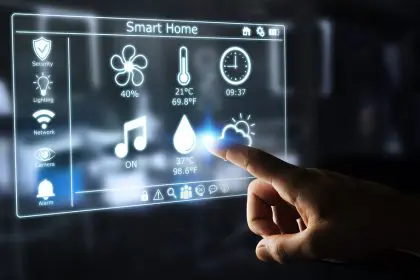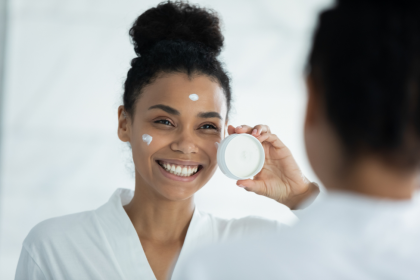That subtle flutter of your eyelids might seem like nothing more than a basic bodily function, but it’s actually broadcasting your mental state to everyone around you. Your blinking pattern—how frequently you blink, how long your eyes stay closed, and how regularly your blinks occur—creates a visible window into your anxiety levels that most people never realize they’re displaying.
The nervous system telegraph
Your blink rate isn’t just about keeping your eyes lubricated—it’s directly wired to your autonomic nervous system, the control center managing your fight-or-flight response. This connection turns your eyelids into a real-time telegraph of your internal stress state, constantly signaling whether you’re calm, focused, or silently panicking.
When anxiety kicks in, this delicate system goes haywire in distinctive ways. For most people, high-stress situations trigger an immediate increase in blink frequency—jumping from the average 15-20 blinks per minute to 30, 40, or even higher. This rapid blinking happens outside conscious awareness, making it nearly impossible to control without specific training.
What makes this particularly fascinating is how this response bypasses our carefully cultivated social masks. Your facial expression might remain perfectly composed during a stressful presentation or uncomfortable conversation, but your eyelids are still faithfully reporting your actual anxiety level to anyone paying attention.
The dopamine connection
The link between blinking and anxiety runs through an unexpected chemical messenger: dopamine. This neurotransmitter, famous for its role in pleasure and reward, also helps regulate blink rate. When stress and anxiety deplete dopamine in certain brain regions, your blink pattern changes accordingly.
During acute anxiety, dopamine pathways become disrupted, creating those characteristic rapid, irregular blinks that signal distress. This biological connection explains why anxiety medications often normalize blinking patterns as they rebalance neurotransmitter systems.
This dopamine relationship creates an interesting neurological feedback loop. Your anxiety changes your blinking, but your blinking pattern can also influence your anxiety level. This bidirectional relationship opens the door to using controlled blinking as a potential intervention for anxiety management—a technique some therapists are beginning to explore.
The blink freeze
While increased blinking is the most common anxiety response, some people experience the opposite: the anxiety-induced “blink freeze.” This pattern appears when someone enters an intensely focused, hypervigilant state during stress—their blink rate plummets as they scan for threats or attempt to process overwhelming information.
The blink freeze often accompanies the deer-in-headlights sensation of being caught off guard or placed on the spot unexpectedly. Politicians being asked unexpected questions often demonstrate this pattern perfectly—their normal blink rate suddenly drops to nearly nothing as their attention narrows intensely.
This reduced blinking creates the wide-eyed appearance we associate with fear or surprise, but it’s actually a functional adaptation. By minimizing the milliseconds your eyes spend closed during blinks, your visual system maximizes information intake during perceived threats or high-stakes situations.
The irregular rhythm
Beyond just frequency, anxiety disrupts the rhythm of your blinking. Under calm conditions, most people blink in a relatively consistent pattern. Anxiety transforms this regularity into erratic, unpredictable fluttering with variable timing between blinks.
This irregularity stems from competing signals in your nervous system. Part of your brain is triggering the protective increase in blink rate, while another part is fighting to maintain visual focus on whatever is causing the stress. The result is a distinctive pattern of clustered blinks followed by extended open periods.
The rhythm disruption creates a visible nervousness that observers pick up on, often subconsciously. Public speaking coaches frequently identify irregular blinking as one of the telltale signs that reveals speaker anxiety even when other aspects of their presentation seem confident.
The partial blink
Anxiety doesn’t just change how often you blink—it transforms how completely your eyelids close. During periods of heightened stress, many people shift from full blinks to partial blinks where the eyelids don’t fully meet, creating a squinting, strained appearance.
These incomplete blinks serve a survival function. By maintaining some visual input even during blinks, your brain ensures continuous monitoring of potential threats. This adaptive response minimizes the milliseconds of blindness that occur during normal blinks.
Unfortunately, these partial blinks don’t serve their primary biological function of lubricating the eyes. This explains why periods of anxiety often lead to dry, irritated eyes—the increased number of blinks would theoretically provide more lubrication, but their incomplete nature actually reduces effective moisture distribution.
The contagious nature
Perhaps most fascinating is how blinking patterns spread between people. When someone with anxiety-induced rapid blinking interacts with others, their conversation partners often unconsciously begin matching the elevated blink rate. This mirroring happens outside awareness but can be measured reliably in social interactions.
This contagion effect stems from our brain’s empathy circuits—the same networks that cause us to yawn when seeing others yawn. When we observe someone’s anxiety-pattern blinking, our own nervous system subtly shifts toward a similar state, creating a form of nonverbal emotional synchronization.
In group settings, this can create cascading effects where one anxious person’s blinking pattern gradually influences the entire group, potentially escalating collective anxiety. Public speakers who don’t manage their own blink-revealed anxiety often find audience members increasingly displaying similar stress patterns.
The deception detector
Security experts and interrogation specialists pay careful attention to blink patterns because they often reveal the cognitive load associated with lying. Constructing and maintaining lies requires significant mental resources, typically triggering distinctive changes in blinking.
The most common deception pattern involves a suppression of blinking while formulating a lie, followed by a rapid increase in blink rate after delivering the false information. This “blink burst” appears to release the tension built up during the cognitive strain of deception.
While not foolproof, this pattern appears reliable enough that airport security personnel and border agents often receive training in recognizing these blink anomalies as potential indicators that warrant additional questioning or attention.
The digital disruption
Our modern screen-dominated environment has dramatically altered baseline blinking patterns, complicating the relationship between blinking and anxiety. Digital device use typically reduces blink rate by up to 60%, creating chronically dry eyes and potential misreadings of natural blinking patterns.
This digital disruption means that someone’s apparently calm, low-frequency blinking might actually represent their “screen stare” rather than genuine emotional composure. Context becomes crucial for accurate interpretation of blinking as an anxiety signal.
The reduced blinking from screen use creates another problem: when anxiety does trigger increased blinking, the jump from the suppressed digital rate to the elevated anxiety rate becomes even more noticeable, potentially making modern humans’ anxiety more visibly obvious than in pre-digital generations.
The cultural complications
Blinking norms vary significantly across cultures, adding another layer of complexity to interpreting anxiety through blink patterns. Research shows substantial differences in average blink rates between different countries and ethnic backgrounds, creating potential for misinterpreting normal cultural variations as anxiety signals.
These cultural differences extend beyond baseline rates to include the social meaning attached to different blinking patterns. In some cultures, prolonged eye contact with minimal blinking communicates respect and attention, while in others, the same pattern might signal aggression or challenge.
These variations highlight the importance of establishing individual baselines rather than universal standards when using blinking to assess anxiety levels. A blink rate that indicates severe anxiety in one person might represent perfect composure in another, depending on their personal and cultural norms.
The practical application
Understanding the connection between blinking and anxiety offers practical applications for both managing your own stress and better understanding others. For personal anxiety management, becoming aware of your blinking pattern provides an early warning system for rising stress levels before they overwhelm you.
Simple awareness exercises can help you recognize when your blink rate begins increasing, offering an opportunity to implement calming techniques before anxiety escalates. This physiological feedback often proves more reliable than emotional awareness alone, as many people recognize physical anxiety signals before consciously acknowledging the feeling.
For understanding others, learning to notice blinking patterns adds a valuable dimension to emotional intelligence. Parents can spot children’s anxiety before verbal expression. Managers might recognize employee stress that goes unmentioned. Friends can detect when casual conversations venture into anxiety-provoking territory.
The control potential
The most empowering aspect of the blinking-anxiety connection is the potential for intervention through consciously modifying your blink pattern. While you can’t directly control many anxiety responses like heart rate or adrenaline release, blinking falls into the category of semi-voluntary actions that bridge conscious and unconscious control.
Deliberately slowing and regulating your blink rate through simple mindfulness exercises sends feedback signals to your nervous system that can actually reduce anxiety levels. By intentionally blinking at a calm, measured pace during stressful situations, you create a physiological pattern associated with relaxation that your body then begins to match.
This bidirectional relationship between blinking and anxiety offers a accessible entry point for managing stress responses. Unlike complex meditation techniques or breathing exercises that might feel obvious in social situations, controlled blinking provides a subtle intervention that others rarely notice but your nervous system clearly registers.
By understanding how your eyelids broadcast your anxiety, you gain both insight into your own stress responses and a practical tool for influencing them. Your blinking pattern isn’t just revealing your anxiety—it might hold a key to managing it.














